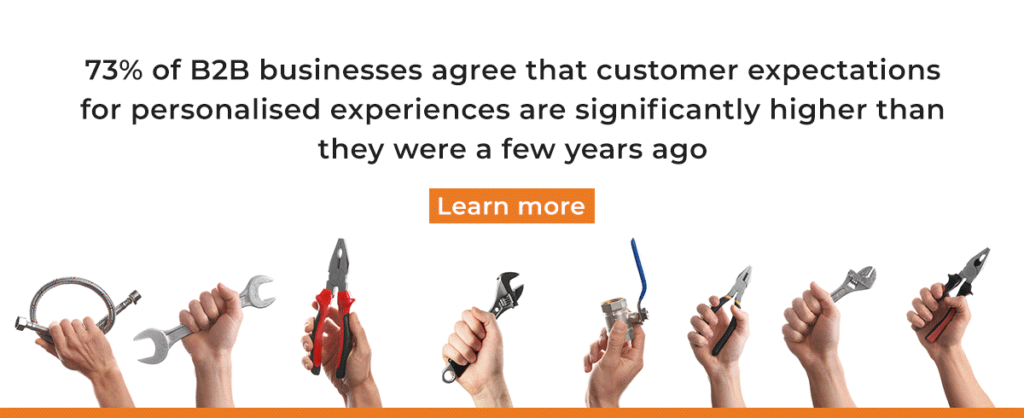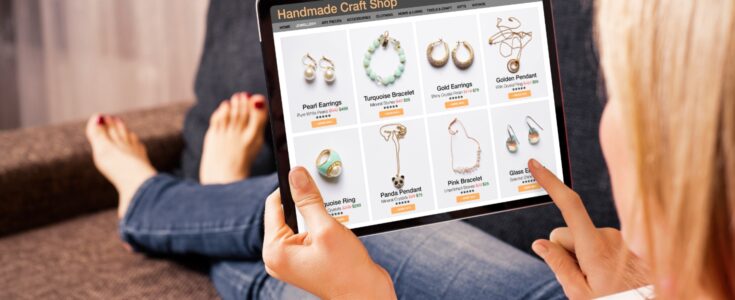
How does personalization enhances customer experience and drive sales in B2B eCommerce?

Personalization is the call of the times. The concept has been around since the inception of marketing, yet there is sluggish adaption when it comes to the B2B sector. Personalization as an idea goes way ahead than just customising your website or altering the promotional messages. It is the process of understanding your buyers and their core perspective to change your holistic approach towards establishing a collaborative connect.
However, as more and more B2B eCommerce companies realize the business outcomes of personalization in their industry, it is quickly becoming a key initiative for enterprises in 2021. Digital Commerce 360 shows an exciting study on how eCommerce giants like Amazon have scaled their B2B sales using such strategies.
But what is B2B eCommerce personalization? How can it be used to improve your business KPIs and give your customers unrivalled experiences and, in turn, boost your sales?
B2B eCommerce Personalization: The Basics (And Why It’s Important)
For the time being, let’s look at personalization as the approach of customizing your on-site experiences (search, browse, recommendations, etc.) with your customer’s unique preferences and shopping habits.
It’s a well-known truth: your accounts – and the specific buyers within those accounts – shop for several things. As a result, you often can’t even target the same set of products to other buyers. Therefore, top B2B eCommerce experts and service providers offer personalization solutions to customize the shopper’s entire experiences.
This customized experience fits their customer’s exact needs automatically without building separate plugins or manual work. But personalization can do more than just offering customized experiences.
Personalization makes pricing a breeze.
As a B2B business, individual customers have prices that vary from other accounts. Therefore, displaying the correct prices for each of your accounts within your product discovery experience is essential, and personalization can allow you to do just that.
Also read: Strategies For Driving B2B Customer Experience (CX) To Boost Revenue
Personalization gives your customers confidence.
The competition in eCommerce is ever-growing. Moreover, due to the COVID-19 pandemic, the competition has gone to another level. Previously, the B2B companies that hesitated to choose the digital pathway have started exploring digital opportunities.
To gain, retain, and sustain your customers, you have to build a deep trust that you recognize their pain points and are ready to help them solve their problems exactly when they need them tackled. With personalization, you can get each of your customers to the products that best suit their needs and preferences at the right time.
Learn how the B2B eCommerce experts at Apexon can help you leverage personalization to deliver seamless customer experience

Ways to conduct B2B eCommerce personalization.
Product recommendations
On B2C websites, showing similar or related products to customers has been practised for a long time. With B2B commerce, you may use an identical strategy, offering your products based on what they are already interested in.
The recommendation may appear on the basis of the following –
- On the product pages based on related/browsed/liked products.
- Based on products added to the cart by the customer.
- Based on what was purchased by the customer earlier.
Some businesses do this through the section “Customers who bought this product have also purchased…”. You may also offer some packages or provide products that are usually bought together.
For instance, if a customer buys a plug, you can offer them sockets or wires. Analyze the buying pattern and use that information to products they are likely to be purchased. All these possibilities to promote cross- and up-sell opportunities in B2B eCommerce will increase the average order value (AOV).
Also read: Strategies To Boost B2B ECommerce Business During COVID-19 Pandemic
Personalized content
Help your B2B customers by providing content according to their designation, country, the type of equipment they buy, or their industry. For instance, a section on the product page can offer several supplementary assets like –
- video tutorials,
- instructions,
- product specifications,
- related blog posts,
- maintenance tips,
- or anything connected with the product that a potential buyer may want to access
Learn how implementing a B2B e-commerce store helped a USA based instrumentation brand establish a global footprint – Download the case study now

Personalized email
Send personalized emails to B2B buyers based on their interests or actions on your site. For instance, you can send your customer a unique proposal based on the product page they have visited or the product they have added to the cart and left the website.
Along with it, you can also share a blog or a video relevant to the customer’s industry or designation of the person who communicates with your business. This helps in building a one-to-one relationship with the customer, putting personalization at the forefront of your B2B approach.
Also read: 10 Easy Tips To Double The Conversion Rate Of Your Online Store
Chatbot
A chatbot is used to interact with customers instantly; the chatbot answers their questions and provides any assistance needed to perfect their shopping experience without making them wait. This personalization tool is entirely interactive. Chatbots are often focused on essential customer support, but with artificial intelligence (AI) development, they have turned into personalized recommendations, and now they perform complex sales interactions.
A Chatbot stores all information about a particular buyer. The communication starts with the buyer’s consent to process the data. Personalization increases with each interaction with the chatbot. For example, the bot remembers and analyzes which product a buyer has purchased, which was not suitable, and so on. This kind of machine learning allows you to increase the number of sales and decrease drop-offs drastically.
Two level B2B personalization
Unlike B2C, B2B personalization operates on two different levels. On the one hand, personalization is aimed at the specific buyer organization, and on the other hand, it is aimed at the individual end-user.
- Personalized catalogue: A personalized catalogue can be created based on the contract finalized with a specific buyer company, to which this particular buyer company or a particular end-user of the company only has access, for example, discounts, goods available for purchase, the agreed prices, etc.
- Personalized processing and delivery of goods: You can prioritize the processing and delivery of orders depending on the buyer organization or the specified end-buyer.
- Personalized production planning: The particular end-user in each buying company should have the ability to view when and what will be delivered.
- Processes and roles depending on the profile: You can assign different roles to different people of the same organization. For example, one employee or end-user adds the order for approval, another end-user confirms the order by approving, and a 3rd person settles the goods at the checkout.
- Personalized credit limits: Credit limits for a specific buying company can be varied, but also within the buying company, there are other roles and limitations. For instance, one end-customer can buy for 1000k$; another can only buy for 100k$.
- Personalized purchase history: The message “You have recently purchased” can be for the purchase of the end-users as well as the buying history of the specific buyer group itself.
Personalization of communication in B2B eCommerce indicates a uniform, but at the same time, individual approach. Therefore, your website should have a simple and straightforward user interface, offer a comfortable, engaging catalogue while assisting buyer activities at every step.
How can you ensure your B2B e-commerce business continues to rise in line with emerging market trends and remains successful?
Your B2B customers are shoppers like everyone else. They have clear expectations about B2B companies’ ability to answer their requirements and personalize the customer experience. By embedding the above eCommerce best practices, you can be confident that your critical elements in the customer journey have a specific level of personalization. As a result, your buyers have an experience that is more aligned with their buying pattern. In the end, all of this will have a positive impact on your revenue.
Contact us now to learn more.




